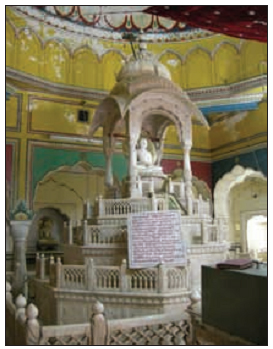
Centre of Jaina Studies Newsletter: SOAS - University of London
The seventeenth through nineteenth centuries saw a vibrant profusion of vernacular religious poetry in the north Indian urban centers of the Digambar Jains. More accurately, because it was all meant to be sung, we should call it hymnody. Starting from the time of Banārsīdās (1586-1643), every generation saw a significant number of men gathering in circles known as goṣṭhīs (assemblies), śailīs (literary styles), maṇḍalīs (circles) and, in a term that seems specific to Jaipur, sahelīs (friends). They listened to sermons and lectures by local and visiting intellectuals. They studied classics of Digambar philosophical and devotional literature, and translated them from Sanskrit, Prakrit and Apabhraṃśa into the vernacular. They also composed and sang bhajans or pads (songs) in the vernacular. While many of the songs demonstrate the privileged position of Braj in the literary culture of late-medieval urban north India, they also give evidence to the ways that literary language was highly localized, as one finds strong elements of Avadhī, Bundēlī, Ḍhuṇḍhāṛī and Khaṛī Bolī, according to where the poet lived. The pads show a deep familiarity with all the contemporary genres of poetic composition; the Digambar poets were enthusiastic participants in the full range of late-medieval vernacular literary culture.
One of the last of the poets of the first rank in this stream was Budhjan. We have specific dates for neither his birth nor death. The date for his earliest composition is VS 1835 (1778 CE), and the latest is VS 1895 (1838 CE). Assuming that he was at least fifteen years old when he wrote his first text, scholars estimate that his dates were roughly 1763-1838 CE. He lived in Jaipur, and was born in the Baj lineage of the Khaṇḍelvāl caste. His given name was Birdhīcand, although he was more generally known as Badhīcand or Bhadīcand, and he adopted Budhjan as his pen name. We also know the names of three generations of his patrilineal ancestors: his father was Nihālcand, his grandfather Pūraṇmal, and his greatgrandfather Sobhācand. His ancestors came from the old Kachhwaha capital of Amer, and had lived for a while in Sanganer before Pūraṇmal settled in Jaipur.[1]

Main altar of Digambara temple Budhacandjī Baj,
Jaipur. Author's photograph, March 2008.
In VS 1864 (1807 CE) Budhjan built a temple to Candraprabh, the eighth Jina, in Jaipur. It is still known after him as the Budhcandjī Baj temple.[2] It is one of six temples in Jaipur that belong to the Gumān Panth. This Panth emerged out of the Digambar Terāpanth under the leadership of Gumānīrām, son of the famous Jaipur Terāpanth intellectual Ṭoḍarmal, in the latter part of the eighteenth century. It is not strictly speaking a separate Digambar sect, but more a style of Terāpanth religiosity that places greater emphasis than the rest of the Terāpanth on a strict adherence to ahiṃsā (non-harm) in all ritual practices, as well as eschewing the worship of unliberated deities such as Kṣetrapāl and goddesses. It is therefore also known as the śuddha āmnāy ("pure tradition") of the Terāpanth. Gumān Panth temples are found mostly in the Jaipur region. The Panth does not differ from either the rest of the Terāpanth, or the Digambar Bīsapanth, on most matters of theology and devotion to the Jinas. There is nothing in Budhjan's pads that would identify him as belonging to the Gumān Panth, and they are sung by Digambar Jains of all affiliations. The situation here is similar to that in Protestant Christianity, in which hymns from authors in a range of denominations are found in the hymnals of most denominations.
Budhjan was a prolific author. He wrote many philosophical, devotional and ritual texts. More than two dozen of these were gathered into his Budhjan Vilās ("The Sport of Budhjan"). The use of the term vilās for such a collection was common in late-medieval and early-modern North India; Mūlcand Jain Śāstri lists thirty-two of them from the sixteenth through nineteenth centuries.[3] Another genre to which he contributed is the set of 700 verses, known as the Sattasaī. His Budhjan Sattasaī, which he completed in VS 1876 (1819 CE) is a collection of 702 Hindi couplets (dohā) on religious topics and worldly wisdom (nīti). He was a prolific translator as well, from Sanskrit, Prakrit and Apabhraṃśa; he translated Umāsvāti's Tattvārtha Sūtra, Kundakunda's Pañcāstikāyasāra, Yogīndu's Yogasāra, Raïdhū's Sammata Bhāvanā, and Sakalakīrti's Varddhamāna Purāṇa Sūcanikā into Hindi. Among his compositions are more than two-hundred-fifty hymns (pads). He is one of the most beloved of all Digambar hymnists in Jaipur, in part due to the engaging clarity and beauty of his writing, but also in part due to the fact that his language is largely the local Ḍhuṇḍhāṛī, and so is more easily understood by Jaipuris than the language of some of the other late medieval and early modern hymnists. Budhjan's pads are all intended to be sung. Most of them designate the rāg or musical mode in which it is to be sung, and in some cases also the tāl or beat.
As seen on the following pages, I have selected here four of his more popular pads for preliminary translation. These represent two of the many genres in which he wrote and which were shared with the larger vernacular literary culture of the time. Three of them are poems of petition. The usual term for this genre is vinaya or vinati, although in these particular pads Budhjan uses the synonym araj. [4] The first of these, known simply as "Budhjan Vinati" or "Budhjan's Petition," is found in many North Indian Digambar hymnals, and in most of them is one of the very first hymns. In some hymnals the poem is given an alternate title, "Darśan Pāṭh," or "Viewing Recitation," indicating that it is to be sung when one first enters a temple and receives darśan of the sacred Jina icon. In a vinati poem the author acknowledges his own helplessness, and so petitions the Lord to respond in a graceful manner to his worthless petitioner. This is an appropriate devotional sentiment with which to enter a temple, take darśan of the icon, and begin one's worship of it. Budhjan begins his poem by proclaiming "I am impure," and that he has therefore come to the feet of the Lordthe Jinafor shelter (śaraṇ). He has lost any sense of who he really is, and so instead of seeking to purify his soul he has pursued external, material and bodily illusions. He has also sought refuge with the gods of other religions, rather than with the true God, the Jina. But due to past karma he had the good fortune to be born in a Jain family, and so had the opportunity to take the sacred sight (daraś, darśan) of the Jina icon in the temple. He is now able to bow in humble submission to the feet of the Lord. He concludes the poem by asking not for great rewards and pleasures in either this life or the next, but simply to be allowed to continue to serve his Lord with devotion (bhakti) in future life after future life.
Two of these poems are in the form called prabhātī, indicating that they are to be sung at dawn, and so are in a slow, meditative mode.[5] (Poem #3 represents both genres.) They describe faithful Jains rising early in the morning, bathing, donning their pure pūjā clothes, and bringing the requisite offerings to the temple to worship the icon of the Jina. They take sight of and worship the icon, listen to a sermon, and in other appropriate ways "get rid of sin (aśubh) / [and] build up merit (puṇya) / as sleep leaves their eyes."
This introduction to Budhjan is part of a larger project to map the place of bhakti in Jain history.[6] As part of that project I conducted four months of fieldwork on the performance of Digambar bhakti in Jaipur from December 2007 through March 2008. Funding for fieldwork was provided by a Senior Short-Term Fellowship from the American Institute of Indian Studies. I thank Dr. K. C. Sogani of Jaipur for his extensive support of this project.
References:
Allchin, Raymond F. (tr.)., Tulsīdās, The Petition to Rāma: Hindi Devotional Hymns of the Seventeenth Century. London: Allen & Unwin, 1966.
Cort, John E., "Dyānatrāy: An Eighteenth Century Digambara Mystical Poet". In Piotr Balcerowicz (ed.), Essays in Jaina Philosophy and Religion, 279- 95. Delhi: Motilal Banarsidas, 2003.
Hawley, John Stratton, Three Bhakti Voices: Mirabai, Surdas, and Kabir in Their Times and Ours. New Delhi: Oxford University Press, 2005.
Jain, Tārācand (ed., Hindi paraphrase), Budhjan Bhajan Saurabh. Mahāvīrjī: Jain Vidyā Saṃsthān, 2006.
Kulbhuṣaṇmatimātā, Āryikā (collector), Humbuja Śramaṇa Siddhānta Pāṭhāvalī. Jaipur: Śrī Digambar Jain Kunthu Vijay Granthmālā Samiti, 1982.
Mallison, Françoise (tr.), Au point du jour: Les prabhātiyāṁ de Narasiṃha Mahetā. Paris: École Française d'Extrême Orient, 1986.
Nyāytīrth, Anūpcand (ed. in chief), Jaypur Digambar Jain Mandir Paricay. Jaipur: Śrī Digambar Jain Mandir Mahāsaṅgh, 1990.
Śāstrī, Mūlcand Jain, Kavivar Budhjan: Vyaktitva evaṃ Kṛtitva. Jaipur: Mahāvīr Granth Akādamī, 1986.
See Mallison 1986 for an extended analysis of the dawn poems by the sixteenth-century Gujarati Hindu poet Narasiṁha Mahetā. Also of relevance to Budhjan's use of this genre is the sixteen-verse Sanskrit Suprabhāta Stotra ("Dawn Hymn") recited by mendicants as part of their daily recitative practice (nitya pāṭh) (Kulbhuṣaṇmatimātā 1982:6-8).
 Prof. Dr. John Cort
Prof. Dr. John Cort